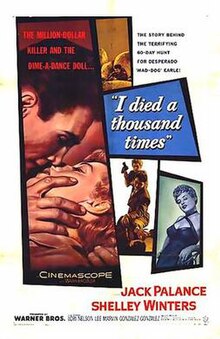I Died a Thousand Times is a 1955 American CinemaScope Warnercolor film noir directed by Stuart Heisler. The drama features Jack Palance as paroled bank robber Roy Earle, with Shelley Winters, Lee Marvin, Earl Holliman, Perry Lopez, Pedro Gonzalez Gonzalez, and Lon Chaney Jr.[1]
| I Died a Thousand Times | |
|---|---|
 Theatrical release poster | |
| Directed by | Stuart Heisler |
| Written by | W.R. Burnett |
| Based on | High Sierra 1940 novel by W. R. Burnett |
| Produced by | Willis Goldbeck |
| Starring | Jack Palance Shelley Winters |
| Cinematography | Ted D. McCord |
| Edited by | Clarence Kolster |
| Music by | David Buttolph |
Production company | Warner Bros. |
| Distributed by | Warner Bros. |
Release date |
|
Running time | 109 minutes |
| Country | United States |
| Language | English |
I Died a Thousand Times is a scene-by-scene remake of High Sierra (1941), which was based upon a novel by W.R. Burnett and starred Humphrey Bogart as Earle. The same story had also been transformed into the Western Colorado Territory (1949), with Joel McCrea.
Plot
editRoy "Mad Dog" Earle (Jack Palance), an aging bank robber, intends to pull off one last heist before retiring.
Sprung from prison by crime boss Big Mac (Lon Chaney Jr.), Earle agrees to plan the robbery of a resort hotel. His partners include the hotheaded Babe (Lee Marvin), easy-going Red (Earl Holliman), and an "inside man" at the hotel, Louis Mendoza (Perry Lopez). Along for the ride is Marie (Shelley Winters), a dance-hall girl whom Babe recently met.
Marie falls in love with Earle, but he is more interested in Velma (Lori Nelson), the club-footed granddaughter of a farmer (Ralph Moody) whom Earle earlier befriended.
Intending to use his share of the loot to pay for Velma's needed operation, Earle goes through with the robbery, only to be thwarted by the ineptitude of his gang, the treachery of the late Big Mac's successors, and the fickle Velma.
With the still faithful Marie by his side, Earle makes a desperate escape into the Sierra Nevada, where a police sniper shoots him down.
Cast
edit- Jack Palance as Roy Earle aka Roy Collins
- Shelley Winters as Marie Garson
- Lori Nelson as Velma Goodhue
- Lee Marvin as Babe Kossuck
- Pedro Gonzalez Gonzalez as Chico
- Lon Chaney Jr. as Big Mac
- Earl Holliman as Red
- Perry Lopez as Louis Mendoza
- Richard Davalos as Lon Preisser
- Howard St. John as Doc Banton
- Nick Adams as Bellboy (uncredited)
- Dennis Hopper as Joe (uncredited)
- Ralph Moody as Pa Goodhue
- Olive Carey as Ma Goodhue
- Dub Taylor as Ed (uncredited)
- Paul Brinegar as Bus Driver (uncredited)
- James Millican as Jack Kranmer
Background
editThe stereotypical, comedy-relief character played by black actor Willie Best in the original film was replaced by a Mexican stereotype played by Pedro Gonzalez Gonzalez. The film marks the second motion picture appearance of Dennis Hopper's six-decade career, and Nick Adams makes an uncredited appearance as a bellhop.
Reception
editBosley Crowther of The New York Times did not like the remake, specifically the screenplay and its inadvertent message, and wrote "Somehow it isn't quite as touching as it was fourteen years ago. Not by a lot-—and the trouble is not wholly Mr. Palance...But the reason this film is not so touching is because it is antique and absurd—-the kind of glorification of the gunman that was obsolescent when High Sierra was made. It is an insult to social institutions and to public intelligence to pull this old mythological hero out of the archives and set him on a mountain top again. The pretense is so blunt and sentimental that it makes the whole thing a total cliché. And the acting does not greatly improve it...It is obvious that High Sierra has come to pretty low ground."[2]
In 2004, film critic Dennis Schwartz wrote "It's a remake that was hardly needed, but at least it keeps things the same as the novel and gives the viewer a chance to observe Jack Palance in the role Bogie made classic and Shelley Winters in Ida Lupino's role. Though both actors acquit themselves well, there's still no comparison with the original legendary actors. I have a thing about remakes of classics, believing there's no point to make them...I had no problems with the pic, in fact it works rather well. If it weren't an unnecessary remake I would think more highly of it."[3]
Has been shown on the Turner Classic Movies show 'Noir Alley' with Eddie Muller.
See also
editReferences
edit- ^ I Died a Thousand Times at the AFI Catalog of Feature Films.
- ^ Crowther, Bosley. The New York Times, "Total Cliche; I Died a Thousand Times' at Globe," film review, November 10, 1955. Accessed: January 29, 2008.
- ^ Schwartz, Dennis. Archived 2016-03-04 at the Wayback Machine Ozus' World Movie Reviews, film review, December 23, 2004. Accessed: December 1, 2009.